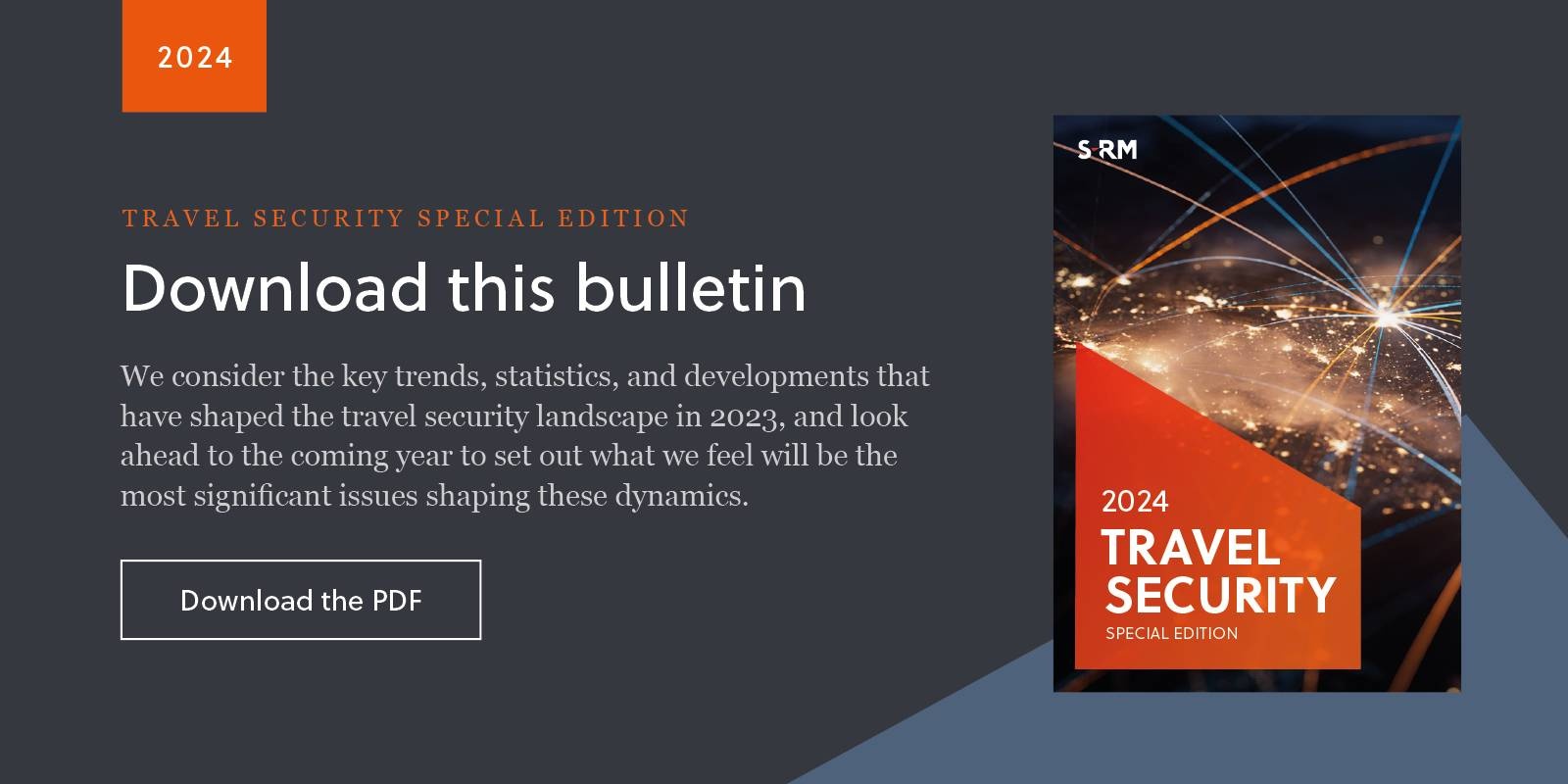S-RM spoke to Paul Padman, Deputy Head of Crisis Response, about some of the global trends in kidnapping, political evacuations and wrongful detention cases, and to hear about some of the key considerations for S-RM’s Crisis Response team when they are working on a live case.
 Paul Padman
Paul Padman
Paul supervises all response cases, coordinating the 24/7 deployment of S-RM’s global response team, and reviewing all critical incidents reported by clients, ensuring each receives an expert and bespoke response. He previously served as a senior Detective at New Scotland Yard and has over thirty years of policing experience and has undertaken as well as supervised major investigations within both the Specialist Operations and Specialist Crime Directorates, specialising in covert policing techniques and countering serious and organised crime groups. He has extensive international operational experience including terrorism, kidnap, piracy, extortion and unlawful detention cases, and has trained law enforcement and other government agencies domestically and internationally.
Q: Response consulting is perhaps most readily associated with kidnap for ransom incidents. As a starting point, could you talk us through the range of work that the team is involved in?
We help our clients respond, with confidence, to a broad range of 40+ perils. These range from kidnap-for-ransom to complex and sophisticated cyber threats and attacks, piracy on the high seas, security incidents in their broadest sense, emergency evacuations, extortions and other threats, detentions, lawsuits and organisational crises.
Put simply we stand ready and capable of responding, within minutes, to pretty much any human crisis and never know, from day to day where the next crisis will spring from, or what it will be.
I think it is fair to say that the majority of our cases involve the response to kidnap, piracy (though less so in the last 18 months), cyber-attacks and other threat extortions. Whilst complex and multi-faceted in scope, context and immediacy, evacuations stemming from political violence, war, natural disasters or regional instability still remain, happily, the exceptions to the rule.
Q: Almost by definition, political evacuations happen in circumstances liable to rapid and unpredictable change. How do you weigh up the risks, and what information do you rely on to make decisions on when and how you evacuate people?
Over the last two to three years, we have planned and executed emergency evacuations in Hong Kong, Mozambique, Myanmar, Ukraine, Israel, and Palestinian Authority as well as several during the COVID pandemic. The golden rule in evacuation decision-making is working out what is actually going on and, if appropriate getting the client out before it is too late, whilst always bearing in mind that evacuation is not always the safest option! In our experience, most clients fail to contingency plan, or make overly complex, inflexible plans which are overly reliant on direction and support from local embassies and national authorities. As ever, flexibility, adaptability, and sharp thinking are our watchwords!
Generally speaking, at the national/pan-national level, governments tend to delay an executive order instructing their nationals to evacuate to the ‘last safe moment’ – in the hope that a diplomatic solution can be found. The key risk by this stage, is that it might already be too late, or an evacuation might only be possible under extremely difficult circumstances, possibly requiring a national/international military operation conducted in a context where there is increased risk to life.
The critical risk for our clients, irrespective of the existence or not of insurance cover, is the timing of a decision that anticipates political decision-making, so that they can evacuate their people before it becomes unsafe or impossible to do so and they are left with no option other than to stand fast, go into ‘hibernation’ and ‘hope for the best’. Inevitably, given the ‘chaos and ‘fog of war’ that will pertain at that moment, the ‘go/no go’ decision often comes down to an instinctive – and subjective – judgement of what is best and safest to do in the circumstances from their perspective rather than that of others who, unsurprisingly, will be acting with their own interests at heart.
Q: Have there been any notable changes in the kidnapping landscape – whether looking at the way kidnappings are carried out, how long they last, the size of ransom payments, and so on – over the past year compared to what you have seen previously?
Kidnapping tends to flourish where state institutions are weak, the rule of law is not effective and the security environment permissive. Prevention is aways the best option. Kidnap invariably changes the lives of the victims, their families and work colleagues.
S-RM has seen a year-on-year increase in kidnap events particularly in Sub-Saharan Africa, Central and Latin America but also in Asia Pacific and Middle East. The long-term trend of local nationals being the likely victim continues. In general, average demands are increasing whilst the durations of kidnap events are also shortening. We are seeing an increase in express and virtual kidnap. Some of these phenomena may be linked to post pandemic travel. For the criminal it is an easier crime to perpetrate with fewer logistical requirements, fewer overheads, a faster pay day and even less probability of being caught.
The critical risk for our clients, irrespective of the existence or not of insurance cover, is the timing of a decision that anticipates political decision-making.ˮ
In the Gulf of Guinea there have been fewer reported piracy kidnap incidents. Nigeria’s NIMASA organisation recently declared that Nigerian waters have been piracy free for almost two years. With the coordination of international maritime patrols and increased local Nigerian enforcement, the current response may be seen as an effective deterrent. However, it is likely still too early to tell whether pirates intent on kidnap have been truly deterred in the long term or merely displaced or supressed for the time being.
Q: Is there a ‘basic formula’ for kidnapping, in terms of how they take place and how negotiations are conducted, that is common globally, or are there major regional differences?
Every kidnap-for-ransom is unique in its circumstances, context, and human impact on the victims. Insofar as there is any commonality, our experience is that the vast majority of criminal kidnappers are motivated by a desire for financial gain. There are regional variations in ‘style’ and the probability of real harm being done to the victim, but most kidnaps-for-ransom conform to the principles outlined here. There is no ‘template’ or ‘formula’, and a kidnapper will continue the extortion until he/she feels that there is no more to be gained – or the risks to the criminal enterprise outweigh the return on the investment. Ultimately, the solution lies in reaching a safe but robust agreement in response to coercive tactics; a release cannot be reached by offering money alone, and significant resilience is required in the face of unpleasant threats and other coercive tactics.
The response to kidnap is art not science; put simply, it is about transforming an unreasonable demand into an achievable one in a negotiation that is anarchic in comparison to traditional business norms and where criminal kidnappers make – and break – rules to suit their own agenda. It is not a quick process, though cases can resolve fast. The response is about managing risk to life in such a way that, unless absolutely unavoidable, decisions are based on what is safest to do rather than that which may be expedient in the circumstances. Above all it requires mutual trust, absolute consistency, moral courage, and endless patience.
Ultimately, kidnap is about people, not property, equipment, data or contracts and resisting the demands of a kidnapper in the negotiation process creates very real risks to the life of the victim. Nonetheless, provided that the risks are thoroughly and sensibly controlled, and the overall response handled sensitively, confidentially and in the best interests of the victim, their family and employer, it is likely that a kidnap case will end with a safe release.
Q: What avenues are available for private sector crisis response operators in cases of wrongful detention, given how we have seen national players such as Russia use wrongful detention to extract concessions or prisoner swaps from other national governments?
Thankfully, wrongful detentions remain rare, but over the last decade, numbers have risen dramatically. For example, 150+ US citizens have been detained by foreign governments in the last 20 years, but over the last 10 years, that number has risen by over 150 percent.
The motivations behind wrongful detention are frequently complex, nuanced and opaque and this can complicate both the assessment and response process. Broadly speaking, however, wrongful detention at the state level amounts to the exploitation of a detained individual in order to gain information, negotiate prisoner releases, or wrest political/other concessions from another government.
Whilst the state-level is, potentially, the most serious level of wrongful detention, seemingly innocuous behaviours that are not intrinsically criminal in nature also present challenges when viewed through the lens of a host country where different customs, morals and standards may apply. The reality is that an incident
does not have to be high profile, or motivated by political considerations, for the unwary traveller to fall foul of a detention that might – or might not – be considered wrongful. Every region is a little different, and so is every country.
So, what scope is there for us as responders? As ever, prevention is likely to be far more cost-effective and less traumatic than the alternative, and time spent mitigating the risk of detention during travel to countries where there is a tangible risk of it is well worth the investment. We are developing a ‘Detention’ training product this year to help clients build an effective training and pre-travel awareness programme that accounts for the risk of wrongful detention. And, if a detention occurs, we are well placed to provide advice and guidance to employers/families, conduct a thorough risk assessment, and coordinate the overall crisis management of the incident.






